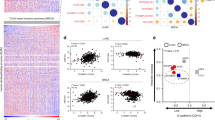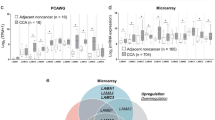Abstract
The tumor suppressor Smad4 is involved in carcinogenesis mainly of the pancreas and colon. Functional inactivation of Smad4 is a genetically late event that occurs upon transition from premalignant stages to invasive and metastatic growth. Smad4 encodes an intracellular messenger common to all signalling cascades induced by members of the transforming growth factor-β (TGF-β) superfamily of cytokines. Despite extensive knowledge about the mechanisms of TGF-β/Smad signal transduction, little is known about Smad4 targets involved in the transition to malignancy. The hallmark of invasive growth is a breakdown of the basement membrane (BM), a specialized sheet of extracellular matrix produced through cooperation of epithelial and stromal cells. Laminin-5, a heterotrimeric epithelial-derived BM component, is commonly lost in carcinomas but not in premalignant tumors. Herein, we report that in human colon and pancreatic tumor cells, Smad4 functions as a positive transcriptional regulator of all three genes encoding laminin-5. Coordinate re-expression of the three laminin-5 chains induced by reconstitution of Smad4 leads to secretion and deposition of the heterotrimeric molecule in BM-like structures. These data define the expression control of an essential BM component as a novel function for the tumor suppressor Smad4.
This is a preview of subscription content, access via your institution
Access options
Subscribe to this journal
Receive 50 print issues and online access
$259.00 per year
only $5.18 per issue
Buy this article
- Purchase on Springer Link
- Instant access to full article PDF
Prices may be subject to local taxes which are calculated during checkout








Similar content being viewed by others
References
Aberdam D, Virolle T, Simon-Assmann P . (2000). Transcriptional regulation of laminin gene expression. Microsc Res Technol 51: 228–237.
Bouziges F, Simo P, Simon-Assmann P, Haffen K, Kedinger M . (1991). Altered deposition of basement-membrane molecules in co-cultures of colonic cancer cells and fibroblasts. Int J Cancer 48: 101–108.
Brabletz T, Hlubek F, Spaderna S, Schmalhofer O, Hiendlmeyer E, Jung A et al. (2005). Invasion and metastasis in colorectal cancer: epithelial–mesenchymal transition, mesenchymal–epithelial transition, stem cells and beta-catenin. Cells Tissues Organs 179: 56–65.
Frank SR, Schroeder M, Fernandez P, Taubert S, Amati B . (2001). Binding of c-Myc to chromatin mediates mitogen-induced acetylation of histone H4 and gene activation. Genes Dev 15: 2069–2082.
Giannelli G, Antonaci S . (2000). Biological and clinical relevance of Laminin-5 in cancer. Clin Exp Metast 18: 439–443.
Givant-Horwitz V, Davidson B, Reich R . (2005). Laminin-induced signaling in tumor cells. Cancer Lett 223: 1–10.
Hanahan D, Weinberg RA . (2000). The hallmarks of cancer. Cell 100: 57–70.
Hlubek F, Jung A, Kotzor N, Kirchner T, Brabletz T . (2001). Expression of the invasion factor laminin gamma2 in colorectal carcinomas is regulated by beta-catenin. Cancer Res 61: 8089–8093.
Imamura T, Kanai F, Kawakami T, Amarsanaa J, Ijichi H, Hoshida Y et al. (2004). Proteomic analysis of the TGF-beta signaling pathway in pancreatic carcinoma cells using stable RNA interference to silence Smad4 expression. Biochem Biophys Res Commun 318: 289–296.
Jazag A, Ijichi H, Kanai F, Imamura T, Guleng B, Ohta M et al. (2005). Smad4 silencing in pancreatic cancer cell lines using stable RNA interference and gene expression profiles induced by transforming growth factor-beta. Oncogene 24: 662–671.
Jonson T, Heidenblad M, Hakansson P, Gorunova L, Johansson B, Fioretos T et al. (2003). Pancreatic carcinoma cell lines with SMAD4 inactivation show distinct expression responses to TGFB1. Genes Chromosomes Cancer 36: 340–352.
Katayama M, Sekiguchi K . (2004). Laminin-5 in epithelial tumour invasion. J Mol Histol 35: 277–286.
Korang K, Christiano AM, Uitto J, Mauviel A . (1995). Differential cytokine modulation of the genes LAMA3, LAMB3, and LAMC2, encoding the constitutive polypeptides, alpha 3, beta 3, and gamma 2, of human laminin 5 in epidermal keratinocytes. FEBS Lett 368: 556–558.
Liotta LA, Kohn EC . (2001). The microenvironment of the tumour–host interface. Nature 411: 375–379.
Lohi J . (2001). Laminin-5 in the progression of carcinomas. Int J Cancer 94: 763–767.
Lu W, Miyazaki K, Mizushima H, Nemoto N . (2001). Immunohistochemical distribution of laminin-5 gamma2 chain and its developmental change in human embryonic and foetal tissues. Histochem J 33: 629–637.
Luettges J, Galehdari H, Bröcker V, Schwarte-Waldhoff I, Henne-Bruns D, Klöppel G et al. (2001). Allelic loss is often the first hit in the biallelic inactivation of the p53 and DPC4 genes during pancreatic carcinogenesis. Am J Pathol 158: 1677–1683.
Lukashev ME, Werb Z . (1998). ECM signalling: orchestrating cell behaviour and misbehaviour. Trends Cell Biol 8: 437–441.
Maitra A, Molberg K, Albores-Saavedra J, Lindberg G . (2000). Loss of dpc4 expression in colonic adenocarcinomas correlates with the presence of metastatic disease. Am J Pathol 157: 1105–1111.
Miyaki M, Iijima T, Konishi M, Sakai K, Ishii A, Yasuno M et al. (1999). Higher frequency of Smad4 gene mutation in human colorectal cancer with distant metastasis. Oncogene 18: 3098–3103.
Mizushima H, Koshikawa N, Moriyama K, Takamura H, Nagashima Y, Hirahara F et al. (1998). Wide distribution of laminin-5 gamma 2 chain in basement membranes of various human tissues. Horm Res 50 (Suppl 2): 7–14.
Muller N, Reinacher-Schick A, Baldus S, van Hengel J, Berx G, Baar A et al. (2002). Smad4 induces the tumor suppressor E-cadherin and P-cadherin in colon carcinoma cells. Oncogene 21: 6049–6058.
Olsen J, Kirkeby LT, Brorsson MM, Dabelsteen S, Troelsen JT, Bordoy R et al. (2003). Converging signals synergistically activate the LAMC2 promoter and lead to accumulation of the laminin gamma 2 chain in human colon carcinoma cells. Biochem J 371: 211–221.
Patarroyo M, Tryggvason K, Virtanen I . (2002). Laminin isoforms in tumor invasion, angiogenesis and metastasis. Semin Cancer Biol 12: 197–207.
Pyke C, Romer J, Kallunki P, Lund LR, Ralfkiaer E, Dano K et al. (1994). The gamma 2 chain of kalinin/laminin 5 is preferentially expressed in invading malignant cells in human cancers. Am J Pathol 145: 782–791.
Pyke C, Salo S, Ralfkiaer E, Romer J, Dano K, Tryggvason K . (1995). Laminin-5 is a marker of invading cancer cells in some human carcinomas and is coexpressed with the receptor for urokinase plasminogen activator in budding cancer cells in colon adenocarcinomas. Cancer Res 55: 4132–4139.
Richter M, Jurek D, Wrba F, Kaserer K, Wurzer G, Karner-Hanusch J et al. (2002). Cells obtained from colorectal microadenomas mirror early premalignant growth patterns in vitro. Eur J Cancer 38: 1937–1945.
Schwarte-Waldhoff I, Klein S, Blass-Kampmann S, Hintelmann A, Eilert C, Dreschers S et al. (1999). DPC4/SMAD4 mediated tumor suppression of colon carcinoma cells is associated with reduced urokinase expression. Oncogene 18: 3152–3158.
Schwarte-Waldhoff I, Volpert O, Bouck N, Sipos B, Hahn S, Klein-Scory S et al. (2000). Smad4/DPC4-mediated tumor suppression through suppression of angiogenesis. Proc Natl Acad Sci USA 97: 9624–9629.
Simon-Assmann P, Lefebvre O, Bellissent-Waydelich A, Olsen J, Orian-Rousseau V, De Arcangelis A . (1998). The laminins: role in intestinal morphogenesis and differentiation. Ann NY Acad Sci 859: 46–64.
Sordat I, Bosman FT, Dorta G, Rousselle P, Aberdam D, Blum AL et al. (1998). Differential expression of laminin-5 subunits and integrin receptors in human colorectal neoplasia. J Pathol 185: 44–52.
Sordat I, Rousselle P, Chaubert P, Petermann O, Aberdam D, Bosman FT et al. (2000). Tumor cell budding and laminin-5 expression in colorectal carcinoma can be modulated by the tissue micro-environment. Int J Cancer 88: 708–717.
Takahashi H, Oda T, Hasebe T, Aoyagi Y, Kinoshita T, Konishi M et al. (2004). Biologically different subgroups of invasive ductal carcinoma of the pancreas: Dpc4 status according to the ratio of intraductal carcinoma components. Clin Cancer Res 10: 3772–3779.
Takahashi S, Hasebe T, Oda T, Sasaki S, Kinoshita T, Konishi M et al. (2002). Cytoplasmic expression of laminin gamma2 chain correlates with postoperative hepatic metastasis and poor prognosis in patients with pancreatic ductal adenocarcinoma. Cancer 94: 1894–1901.
Takaku K, Oshima M, Miyoshi H, Matsui M, Seldin MF, Taketo MM . (1998). Intestinal tumorigenesis in compound mutant mice of both Dpc4 (Smad4) and Apc genes. Cell 92: 645–656.
Teller IC, Beaulieu JF . (2001). Interactions between laminin and epithelial cells in intestinal health and disease. Expert Rev Mol Med 2001: 1–18.
Thiery JP . (2002). Epithelial–mesenchymal transitions in tumour progression. Nat Rev Cancer 2: 442–454.
Volmer MW, Radacz Y, Hahn SA, Klein-Scory S, Stuhler K, Zapatka M et al. (2004). Tumor suppressor Smad4 mediates downregulation of the anti-adhesive invasion-promoting matricellular protein SPARC: landscaping activity of Smad4 as revealed by a ‘secretome’ analysis. Proteomics 4: 1324–1334.
Wayner EA, Gil SG, Murphy GF, Wilke MS, Carter WG . (1993). Epiligrin, a component of epithelial basement membranes, is an adhesive ligand for alpha 3 beta 1 positive T lymphocytes. J Cell Biol 121: 1141–1152.
Wilentz RE, Iacobuzio-Donahue CA, Argani P, McCarthy DM, Parsons JL, Yeo CJ et al. (2000). Loss of expression of Dpc4 in pancreatic intraepithelial neoplasia: evidence that DPC4 inactivation occurs late in neoplastic progression. Cancer Res 60: 2002–2006.
Yuen HW, Ziober AF, Gopal P, Nasrallah I, Falls EM, Meneguzzi G et al. (2005). Suppression of laminin-5 expression leads to increased motility, tumorigenicity, and invasion. Exp Cell Res 309: 198–210.
Acknowledgements
We thank H Kalthoff and H Ungefroren for providing recombinant retrovirus, B Marian for providing LT97 cells, F Kanai for providing the Smad4 knockdown vector pcPUR+U6-Smad4i, A Menssen and H Hermeking for introduction in the ChIP assay technology, S Hahn for sequencing and S Klein-Scory and K Schulmann for critically reading the manuscript. This work was supported by grants from the Deutsche Krebshilfe – Dr Mildred Scheel-Stiftung (10-1804-Schw I) and the Wilhelm Sander-Stiftung (99.101.1) to IS-W and WS, by the FoRUM program of the Ruhr-University of Bochum and by Inserm and a grant from the Canceropôle Grand Est to PSA.
Author information
Authors and Affiliations
Corresponding author
Rights and permissions
About this article
Cite this article
Zapatka, M., Zboralski, D., Radacz, Y. et al. Basement membrane component laminin-5 is a target of the tumor suppressor Smad4. Oncogene 26, 1417–1427 (2007). https://doi.org/10.1038/sj.onc.1209918
Received:
Revised:
Accepted:
Published:
Issue Date:
DOI: https://doi.org/10.1038/sj.onc.1209918
Keywords
This article is cited by
-
Secreted CLIC3 drives cancer progression through its glutathione-dependent oxidoreductase activity
Nature Communications (2017)
-
Glucose-regulated protein 58 modulates β-catenin protein stability in a cervical adenocarcinoma cell line
BMC Cancer (2014)
-
Uncoupled responses of Smad4-deficient cancer cells to TNFα result in secretion of monomeric laminin-γ2
Molecular Cancer (2010)
-
Modulation of TGF-β-inducible hypermotility by EGF and other factors in human prostate epithelial cells and keratinocytes
In Vitro Cellular & Developmental Biology - Animal (2010)
-
The Tumor Microenvironment in Colorectal Carcinogenesis
Cancer Microenvironment (2010)



